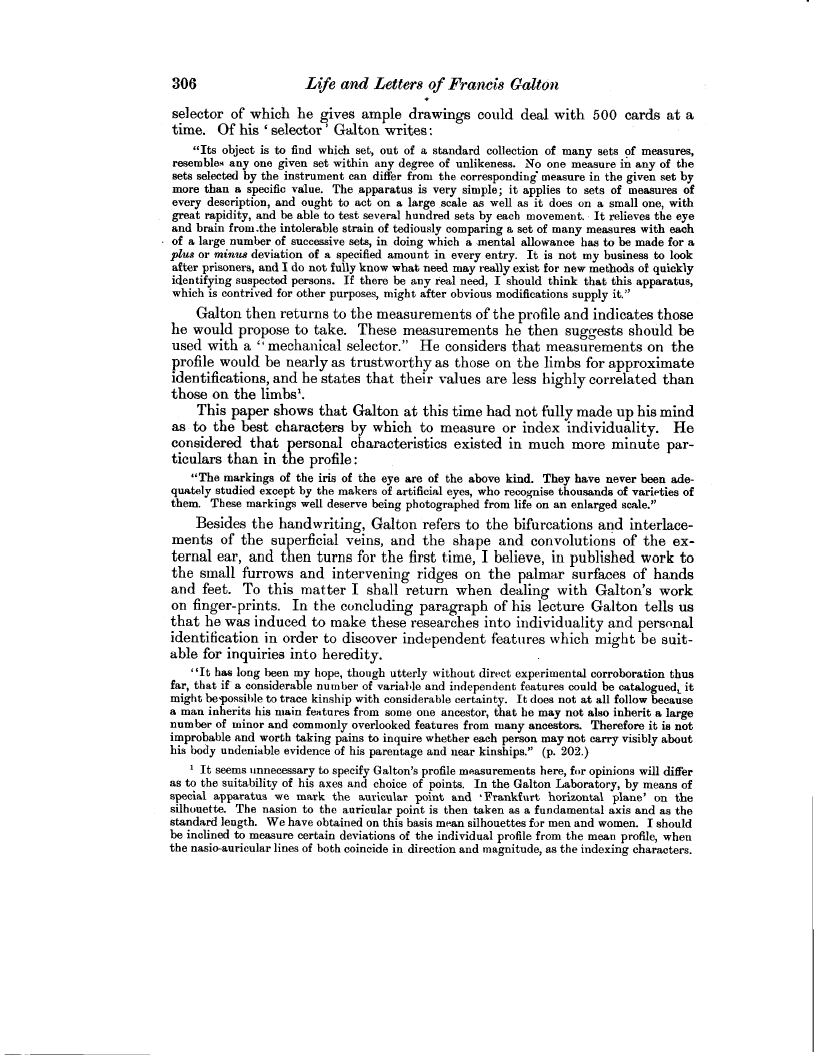306 Life and Letters of Francis Galton
selector of which he gives ample drawings could deal with 500 cards at a time. Of his `selector' Galton writes
"Its object is to find which set, out of a standard collection of many sets of measures, resembleM any one given set within any degree of unlikeness. No one measure in any of the sets selected by the instrument can differ from the corresponding measure in the given set by more than a specific value. The apparatus is very simple; it applies to sets of measures of every description, and ought to act on a large scale as well as it does on a small one, with great rapidity, and be able to test several hundred sets by each movement. It relieves the eye and brain from.the intolerable strain of tediously comparing a set of many measures with each of a large number of successive sets, in doing which a mental allowance has to be made for a plus or minus deviation of a specified amount in every entry. It is not my business to look after prisoners, and I do not fully know what need may really exist for new methods of quickly identifying suspected persons. If there be any real need, I should think that this apparatus, which is contrived for other purposes, might after obvious modifications supply it."
Galton then returns to the measurements of the profile and indicates those he would propose to take. These measurements he then suggests should be used with a " mechanical selector." He considers that measurements on the profile would be nearly as trustworthy as those on the limbs for approximate identifications, and he states that their values are less highly correlated than those on the limbs'.
This paper shows that Galton at this time had not fully made up his mind as to the best characters by which to measure or index individuality. He considered that personal characteristics existed in much more minute particulars than in the profile
"The markings of the iris of the eye are of the above kind. They have never been adequately studied except by the makers of artificial eyes, who recognise thousands of varieties of them. These markings well deserve being photographed from life on an enlarged scale."
Besides the handwriting, Galton refers to the bifurcations and interlacements of the superficial veins, and the shape and convolutions of the external ear, and then turns for the first time, I believe, in published work to the small furrows and intervening ridges on the palmar surfaces of hands and feet. To this matter I shall return when dealing with Galton's work on finger-prints. In the concluding paragraph of his lecture Galton tells us that he was induced to make these researches into individuality and personal identification in order to discover independent features which might be suitable for inquiries into heredity.
"It has long been my hope, though utterly without direct experimental corroboration thus far, that if a considerable number of variable and independent features could be catalogued, it might be'possible to trace kinship with considerable certainty. It does not at all follow because a man inherits his main features from some one ancestor, that be may not also inherit a large number of minor and commonly overlooked features from many ancestors. Therefore it is not improbable and worth taking pains to inquire whether each person may not carry visibly about his body undeniable evidence of his parentage and near kinships." (p. 202.)
1 It seems unnecessary to specify Galton's profile measurements here, for opinions will differ as to the suitability of his axes and choice of points. In the Galton Laboratory, by means of special apparatus we mark the auricular point and -Frankfurt horizontal plane' on the silhouette. The nasion to the auricular point is then taken as a fundamental axis and as the standard length. We have obtained on this basis mean silhouettes for men and women. I should be inclined to measure certain deviations of the individual profile from the mean profile, when the nasio-auricular lines of both coincide in direction and magnitude, as the indexing characters.

